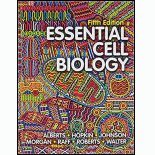
Concept explainers
To explain: The reason behind an anaerobic condition when the cell could not discard pyruvate as a waste product.
Introduction: The cells growing in the absence of oxygen (anaerobic condition) in which the end product of glycolysis is pyruvate undergoes fermentation. In the process of fermentation, NAD+ is regenerated from NADH by transferring electron to organic molecule like lactate and ethanol.
Explanation of Solution
In the process of fermentation, in anaerobic condition of cell NAD+ is regenerated from NADH by transferring electron to organic molecule. To continue the process of glycolysis in the cell, cells need to regenerate NAD+. So, without the fermentation process there is no other methodical way to generate NAD+. In absence of NAD+, the glycolysis process is discontinued from the step- 6 that is energy generation phage where the oxidation of glyceraldehydes 3-phosphate produce 1, 3-biphosphoglycerate to continue the glycolysis process.
To explain: The products from glucose accumulate in the cell unable to generate either lactate or ethanol by fermentation.
Introduction: The cells growing in the absence of oxygen (anaerobic condition) in which the end product of glycolysis is pyruvate undergoes fermentation. In the process of fermentation, NAD+ is regenerated from NADH by transferring electron to organic molecule like lactate and ethanol.
Explanation of Solution
In the fermentation process in presence of pyruvate, the NAD+ is reinitiated from NADH by transferring electron to organic molecule like lactate and ethanol. To keep glycolysis continuing in the cell, it needs regenerated NAD+. There is no suitable way rather than the fermentation to produce NAD+. In glycolysis process in absence of regenerated NAD+ at energy generation step of glyceraldehyde 3-phosphate to 1, 3-biphosphoglycerate will not occur. The product glyceraldehydes 3-phosphate would accumulate in the cell unable to make either lactate or ethanol, neither it would able to regenerate NAD+. So, in this step also glycolysis process is blocked.
Want to see more full solutions like this?
Chapter 13 Solutions
Essential Cell Biology 5e
- Describe the principle of homeostasis.arrow_forwardExplain how the hormones of the glands listed below travel around the body to target organs and tissues : Pituitary gland Hypothalamus Thyroid Parathyroid Adrenal Pineal Pancreas(islets of langerhans) Gonads (testes and ovaries) Placentaarrow_forwardWhat are the functions of the hormones produced in the glands listed below: Pituitary gland Hypothalamus Thyroid Parathyroid Adrenal Pineal Pancreas(islets of langerhans) Gonads (testes and ovaries) Placentaarrow_forward
- Describe the hormones produced in the glands listed below: Pituitary gland Hypothalamus Thyroid Parathyroid Adrenal Pineal Pancreas(islets of langerhans) Gonads (testes and ovaries) Placentaarrow_forwardPlease help me calculate drug dosage from the following information: Patient weight: 35 pounds, so 15.9 kilograms (got this by dividing 35 pounds by 2.2 kilograms) Drug dose: 0.05mg/kg Drug concentration: 2mg/mLarrow_forwardA 25-year-old woman presents to the emergency department with a 2-day history of fever, chills, severe headache, and confusion. She recently returned from a trip to sub-Saharan Africa, where she did not take malaria prophylaxis. On examination, she is febrile (39.8°C/103.6°F) and hypotensive. Laboratory studies reveal hemoglobin of 8.0 g/dL, platelet count of 50,000/μL, and evidence of hemoglobinuria. A peripheral blood smear shows ring forms and banana-shaped gametocytes. Which of the following Plasmodium species is most likely responsible for her severe symptoms? A. Plasmodium vivax B. Plasmodium ovale C. Plasmodium malariae D. Plasmodium falciparumarrow_forward
- please fill in missing parts , thank youarrow_forwardplease draw in the answers, thank youarrow_forwarda. On this first grid, assume that the DNA and RNA templates are read left to right. DNA DNA mRNA codon tRNA anticodon polypeptide _strand strand C с A T G A U G C A TRP b. Now do this AGAIN assuming that the DNA and RNA templates are read right to left. DNA DNA strand strand C mRNA codon tRNA anticodon polypeptide 0 A T G A U G с A TRParrow_forward
 Human Anatomy & Physiology (11th Edition)BiologyISBN:9780134580999Author:Elaine N. Marieb, Katja N. HoehnPublisher:PEARSON
Human Anatomy & Physiology (11th Edition)BiologyISBN:9780134580999Author:Elaine N. Marieb, Katja N. HoehnPublisher:PEARSON Biology 2eBiologyISBN:9781947172517Author:Matthew Douglas, Jung Choi, Mary Ann ClarkPublisher:OpenStax
Biology 2eBiologyISBN:9781947172517Author:Matthew Douglas, Jung Choi, Mary Ann ClarkPublisher:OpenStax Anatomy & PhysiologyBiologyISBN:9781259398629Author:McKinley, Michael P., O'loughlin, Valerie Dean, Bidle, Theresa StouterPublisher:Mcgraw Hill Education,
Anatomy & PhysiologyBiologyISBN:9781259398629Author:McKinley, Michael P., O'loughlin, Valerie Dean, Bidle, Theresa StouterPublisher:Mcgraw Hill Education, Molecular Biology of the Cell (Sixth Edition)BiologyISBN:9780815344322Author:Bruce Alberts, Alexander D. Johnson, Julian Lewis, David Morgan, Martin Raff, Keith Roberts, Peter WalterPublisher:W. W. Norton & Company
Molecular Biology of the Cell (Sixth Edition)BiologyISBN:9780815344322Author:Bruce Alberts, Alexander D. Johnson, Julian Lewis, David Morgan, Martin Raff, Keith Roberts, Peter WalterPublisher:W. W. Norton & Company Laboratory Manual For Human Anatomy & PhysiologyBiologyISBN:9781260159363Author:Martin, Terry R., Prentice-craver, CynthiaPublisher:McGraw-Hill Publishing Co.
Laboratory Manual For Human Anatomy & PhysiologyBiologyISBN:9781260159363Author:Martin, Terry R., Prentice-craver, CynthiaPublisher:McGraw-Hill Publishing Co. Inquiry Into Life (16th Edition)BiologyISBN:9781260231700Author:Sylvia S. Mader, Michael WindelspechtPublisher:McGraw Hill Education
Inquiry Into Life (16th Edition)BiologyISBN:9781260231700Author:Sylvia S. Mader, Michael WindelspechtPublisher:McGraw Hill Education





